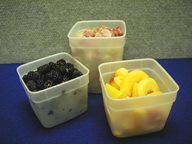I have a confession to make. No, it’s not that I’ve been silent on this blog site for 11 months. Our followers know that, and I am sorry. My confession is that despite my teaching others to manage their inventory of frozen foods well, it turns out I am not a good example this month.
 For the past few weeks I’ve had to clean out some freezers in our food preservation lab. Some foods were missing labels and dates and others obviously had been poorly packaged (but just a few of them, really!). I am sure the intent of our workers had been to take care of an immediate need cleaning up after a workshop or late night experiment. But the outcome was that no one had gone back very quickly and corrected the situation. And that chest freezer, where there was not a great demand on the space, had become quite unorganized and full of really old and some freezer-burned food near the bottom.
For the past few weeks I’ve had to clean out some freezers in our food preservation lab. Some foods were missing labels and dates and others obviously had been poorly packaged (but just a few of them, really!). I am sure the intent of our workers had been to take care of an immediate need cleaning up after a workshop or late night experiment. But the outcome was that no one had gone back very quickly and corrected the situation. And that chest freezer, where there was not a great demand on the space, had become quite unorganized and full of really old and some freezer-burned food near the bottom.
Now I want to clean out my home freezer so I can buy a new one. The labeling of packages is in much better situation at home. However, I am finding some that “got lost” and pushed to the back of this upright. They are older than should still be in there. So here is my message for beginning of summer. This article starts a short series on freezing of foods.
Freezing is a great food preservation method, especially for being able to store uncooked, or barely cooked, foods that can be used in many ways when thawed. I am dreaming of the fresh strawberries now in our fields, and the blueberries, blackberries and other fruits to come this summer. If frozen without sugar and tray-frozen before packaging, I know I can decide later whether to make jam, syrups, cobblers or pies. However the quality of foods in the freezer will deteriorate over time. Certain practices can better preserve that quality.

Choose packaging (e.g., bags, wraps, boxes or jars) that will prevent moisture loss from the food. Moisture and oxygen can pass through some packaging material itself and of course through poorly connected lids and seals. Drying of food surfaces (i.e., freezer burn) results in poor quality texture and taste. Best packaging also prevents transmission of odors within the freezer. Most people prefer bags and wraps, although glass jars and rigid plastic freezer containers with tight seals keep food quality very well. Choose plastics and foils that indicate freezer quality and weight (versus just those marked “food storage”). Not all plastics and foils are the same in the way they allow or block transmission of moisture and oxygen.
Whether you choose boxes, bags or wraps, make sure all seals and folds are very tight and prevent air loss or entry. Boxes with snap-on lids and jars with twist-on lids are not all the same, either. Snap-on lids should have a deep and tight overlap of the lid channel for sealing and the top rim of the bottom part. Twist- or turn-on lids should have some type of gasket to prevent air gaps.
 The shape and type of package, as well as type of food, can also influence how much headspace is needed. Headspace is empty space between the food and top of the container (or bag) that allows room for expansion as water in the food freezes to ice. But, too much air left in the package is not good for food quality. See guidelines for headspace at our website. More about packaging is written here.
The shape and type of package, as well as type of food, can also influence how much headspace is needed. Headspace is empty space between the food and top of the container (or bag) that allows room for expansion as water in the food freezes to ice. But, too much air left in the package is not good for food quality. See guidelines for headspace at our website. More about packaging is written here.
After packaging your food, label it with the food type and date. Then, actively manage your inventory. One option is to make a table or chart of foods going in your freezer by date that can be checked off as your remove items. Paper and pencil work as does one on a tablet or computer. (Some of you may be lucky enough to have built-in computer technology on your newer freezer!) If you are not a person to keep up with lists, at least re-organize your inventory when you add new foods. Put the newest foods toward the bottom or back and bring older foods toward the front or top. Labels should be easy to read and follow. Find a system that works for you. It’s a shame to waste good food, let alone the time and expense of packaging you put into preserving your food.
In my next article, I’ll cover some other tips for successful freezing. You can also read more at the National Center for Home Food Preservation website, under “How Do I…..Freeze.”
Oh, and actually, that lab freezer still will be storing some of that freezer-burned food. I need those example for the next class I’m teaching or photos! But your own, real food supply, like mine, shouldn’t include those items.